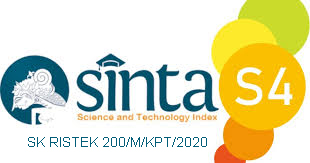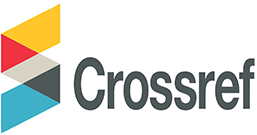Implementation of K-Means clustering algorithm in mapping the groups of graduated or dropped-out students in the Management Department of the National University
Abstract
This study aims to determine the characteristics of students who are likely to graduate or drop out (DO) in the management department of the National University, Jakarta. The study was conducted by implementing the K-Means algorithm, where each data is grouped according to the closest distance to the centroid. Determination of Cluster C1 graduate or C2 drop out is based on the attributes of status of students (active, leave, out and non-active), educational status (graduated or DO), GPA, total credits taken and length of study. To facilitate the clustering process, Orange tools are used that provide K-Means algorithm features. The total data input in this study were 1988 students from various classes. As a result, a pattern or mapping of graduated or DO students was found based on the attributes mentioned earlier. Testing the results of this cluster with the silhouette method, by measuring the distance between cluster members, both C1 and C2, showed good Silhouetter value, reaching 85%. The management department, National University can use the results of this study to predict the graduation of their students.
Keywords
Full Text:
PDFReferences
Universitas Nasional, “Sejarah Perkembangan Fakultas Ekonomi Universitas Nasional,” Universitas Nasional, 2020. [Online]. Available: http://fe.unas.ac.id/profil-fakultas/sejarah-perkembangan-fakultas/.
W. M. P. Dhuhita, “Clustering Menggunakan Metode K-Means Untuk Menentukan Status Gizi Balita,” vol. 15, no. 2, 2015.
M. H. Adiya and Y. Desnelita, “Jurnal Nasional Teknologi dan Sistem Informasi Penerapan Algoritma K-Means Untuk Clustering Data Obat-Obatan Pada RSUD Pekanbaru,” vol. 01, pp. 17–24, 2019.
A. V. Vidhyapeetham, “Crime Analysis and Prediction using Optimized K-Means Algorithm 1 1,” no. Iccmc, pp. 915–918, 2020.
P. Manivannan, “Dengue Fever Prediction Using K-Means Clustering Algorithm,” pp. 1–5, 2017.
S. Kaur, “Disease Prediction using Hybrid K-means and Support Vector Machine,” 2016.
X. Chen and P. Miao, “Image Segmentation Algorithm Based on Particle Swarm Optimization with K-means Optimization,” 2019 IEEE Int. Conf. Power, Intell. Comput. Syst., pp. 156–159, 2019.
R. Alzu, “Medical Image Segmentation via Optimized K-Means,” pp. 959–962, 2017.
F. Natalia, R. I. Desanti, and F. V. Ferdinand, “Prediction and Visualization of Flood Occurences in Tangerang using K-Medoids , DBScan , and X-Means Clustering Algorithms,” pp. 43–47, 2019.
A. Suresh, “Prediction of major crop yields of Tamilnadu using K-means and Modified KNN,” 2018 3rd Int. Conf. Commun. Electron. Syst., no. Icces, pp. 88–93, 2018.
E. Hot and V. Popovi, “Soil data clustering by using K-means and fuzzy K-means algorithm,” pp. 890–893, 2015.
ASRONI and R. ADRIAN, “Penerapan Metode K-Means Untuk Clustering Mahasiswa Berdasarkan Nilai Akademik Dengan Weka Interface Studi Kasus Pada Jurusan Teknik Informatika UMM Magelang,” J. Ilm. SEMESTA Tek., vol. 18, no. 1, pp. 76–82, 2015.
F. Nur, R. Fauzan, J. Aziz, B. D. Setiawan, and I. Arwani, “Implementasi Algoritma K-Means untuk Klasterisasi Kinerja Akademik Mahasiswa,” vol. 2, no. 6, pp. 2243–2251, 2018.
H. Priyatman, F. Sajid, and D. Haldivany, “Klasterisasi Menggunakan Algoritma K-Means Clustering untuk Memprediksi Waktu Kelulusan,” vol. 5, no. 1, pp. 62–66, 2019.
A. Fadlil, M. Teknik, I. Universitas, A. Dahlan, T. Elektro, and U. Ahmad, “Implementasi Metode K-Means Dalam Pemetaan Kelompok Mahasiswa Melalui Data Aktivitas Kuliah,” vol. 3, no. 1, pp. 22–31, 2018.
D. W. Widodo, “Implementasi Algoritma K-Means Clustering Untuk Mengetahui Bidang Skripsi Mahasiswa Multimedia Pendidikan Teknik Informatika Dan Komputer Universitas Negeri Jakarta,” J. Pinter, vol. 1, no. 2, pp. 157–166, 2017.
B. Poerwanto and R. . Fa’rifah, “Analisis cluster k-means dalam pengelompokan kemampuan mahasiswa,” J. Sci. Pinisi, vol. 2, no. 2, pp. 92–96, 2015.
S. Agrawal, “Prediction of Students Academic Execution Using K-Means and K-Medoids Clustering Technique,” 2018 2nd Int. Conf. Trends Electron. Informatics, no. Icoei, pp. 1308–1315, 2018.
F. M. IZZADIN, “Optimasi Jumlah Cluster K-Means Dengan Metode Elbow dan Silhouette Untuk Pengelompokan Luas Panen Palawija Kabupaten Magelang Pada Tahun 2017,” Medium The Startup, 2019. [Online]. Available: https://medium.com/@16611050/optimasi-jumlah-cluster-k-means-dengan-metode-elbow-dan-silhouette-untuk-pengelompokan-luas-panen-200131515c4f.
DOI: https://doi.org/10.31326/jisa.v4i1.848
Refbacks
- There are currently no refbacks.
Copyright (c) 2021 Muhammad Darwis, Liyando Hermawan Hasibuan, Mochammad Firmansyah, Nur Ahady, Rizka Tiaharyadini

This work is licensed under a Creative Commons Attribution-ShareAlike 4.0 International License.
JOURNAL IDENTITY
Journal Name: JISA (Jurnal Informatika dan Sains)
e-ISSN: 2614-8404, p-ISSN: 2776-3234
Publisher: Program Studi Teknik Informatika Universitas Trilogi
Publication Schedule: June and December
Language: English
APC: The Journal Charges Fees for Publishing
Indexing: EBSCO , DOAJ, Google Scholar, Arsip Relawan Jurnal Indonesia, Directory of Research Journals Indexing, Index Copernicus International, PKP Index, Science and Technology Index (SINTA, S4) , Garuda Index
OAI address: http://trilogi.ac.id/journal/ks/index.php/JISA/oai
Contact: jisa@trilogi.ac.id
Sponsored by: DOI – Digital Object Identifier Crossref, Universitas Trilogi
In Collaboration With: Indonesian Artificial Intelligent Ecosystem(IAIE), Relawan Jurnal Indonesia, Jurnal Teknologi dan Sistem Komputer (JTSiskom)
JISA (Jurnal Informatika dan Sains) is Published by Program Studi Teknik Informatika, Universitas Trilogi under Creative Commons Attribution-ShareAlike 4.0 International License.


















